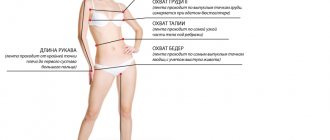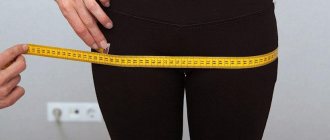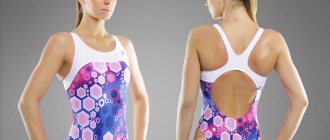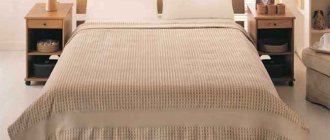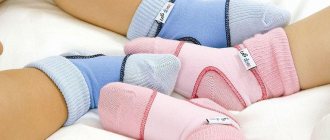Do you know that the most crucial and primary moment in creating patterns is taking measurements? And the correct fit of the product on the figure will depend on how seriously and carefully we approach this task.
To create a pattern for the base of women's trousers, we will need basic and additional measurements (measurements) of the figure.
Measurements for creating a pattern for women's trousers =»ru-ru»>
| From | Waist circumference | Measure around the figure at the narrowest point of the waist |
| About | Hip girth | Measure horizontally along the most protruding places of the buttocks and thighs, taking into account the protrusion of the abdomen. At this stage it will be convenient to measure the Hip Height level |
| Ub | Level (height) of hips | Measure from the waist down to the hip line |
| Sun | Seat height | Measure along the side, sitting on a chair, the distance from the waist line to the plane of the chair. It is more convenient to take measurements with a ruler |
| Dbrück | Length trousers | Measure from the waist to the floor at the side to the desired pant length |
| Shn | Pants bottom width | Measure the desired width of the trousers at the bottom, full size (in girth) |
The measurements described in the table below are needed for tight-fitting trousers. And they are test ones, that is, with their help you can check the pattern in one area or another and make sure that the trousers will not be too small for you (do not forget to take into account the allowance for freedom of fit).
| Hip circumference | Upper leg circumference | Measure at the widest part of the leg at the top |
| Obx. knee | Knee circumference | Measure the circumference above the kneecap, as well as the circumference of the knee with the leg bent. Record the larger value |
| Obx. shins | Calf circumference | Measure the circumference of the shin at the widest part |
| Obx. ankles | Ankle circumference | Measure the circumference of the ankle at the narrow part |
| Dl. step | Length of trousers along the inner surface of the leg | Measured along the inner surface of the leg from the groin to the desired length of the trousers (the measurement is optional, it is a control) |
Now let's look at the measurements to control the balance of the product. Each of us has our own characteristics of the figure, I mean the roundness of the hips, abdomen, buttocks))) For some they are “rounded” and protrude to a greater extent, for others to a lesser extent. All this undoubtedly affects the length of the pattern parts (for example, if the hips are round, the length of the side seam increases to go around it; if the buttocks are protruding, the length of the middle seam increases; if there is a protruding belly, it is necessary to move the front seam line to the right (from 1 to 2 cm).
Before we begin measuring balance standards, consider the following figure.
In order to understand the pattern, you need to know the names of all the cuts (future seams) on it and where this or that measurement is placed. The figure shows the names of the seams and the name of the measurements in this area.
Do you know what an elephant is? Slonka is a term used in the sewing industry. The seam of the seat (middle seam), that is, the seam connecting the right and left halves of the trousers in the center, is called the elephant. Measured from front waist to back waist.
How to properly prepare for taking measurements
You won't be able to take your own measurements, so ask someone to help you. And I’ll tell you how to work when taking measurements on behalf of a tailor.
The accuracy of your pattern will depend on how correctly you take measurements from the figure, so treat the preparation stage no less responsibly. So, in my work I use such mandatory tools as:
1. Measuring tape
2. Linen elastic - 1.10 m.
3. Notepad for recording measurements
4. Shoulder pad.
This is a device with the help of which measurements from a figure are taken most simply, and most importantly accurately. The overlay is a product made of cotton fabric with ties. When taking measurements, it is fixed at the neckline and under the arms, thereby determining the line of the shoulder cut on the figure. With it, we immediately see control points on the figure, which are then used in constructing the pattern. It also allows you to get the right balance of the product for different body types.
Learn how to sew a tailor's shoulder pad and get a free pattern here >>>
5. Plumb lines. These are devices for accurately taking three types of width measurements - Шг1 , Шг2, Шс . You can make them yourself from a cord 1.30 m long and weights. For example, I use metal rings from curtains as them.
4 main rules for taking measurements
01. It is not necessary to take measurements from a naked body; you can wear tight, thin clothes without layers. Underwear is necessary, and it is advisable to wear the type of bra with which you plan to wear the product. The biggest discrepancies when taking measurements have happened to nursing mothers, since breast volume can change. Take this fact into account.
02. Measurements should be taken from a relaxed figure; you should not try to pull in your stomach or straighten your back in an unnatural way. The client should stand as he does in normal life.
03. Place the shoulder pad on the client and securely fasten it with ties so that the shoulder edge of the pad is where the shoulder line is. When taking measurements, it should be in one position all the time and not move.
04. Tie an elastic band around your waist. Look in the mirror and ask the client to fix the elastic band to the part of the body where, in his opinion, the waist is located. Explain that when you sew a dress with a cut at the waist, this is where the skirt will begin.
Balance measurements =»ru-ru»>
| Dl. to the floor on the side | Side floor length | Measure from the waist down the side to the floor |
| Dl. to the floor in front | Front floor length | Measure from the waist down the front, in the center of the figure, vertically down to the floor |
| Dl. to the floor at the back | Rear floor length | Measure from the waist down, vertically across the protruding buttocks (i.e. on the right or left side, but not in the center) to the floor |
Having measured the balance measures, you need to analyze their values. To do this, we will find the difference between them and lengthen or shorten the length on the corresponding details of the pattern, relative to the horizontal - the waist line. For example, if the measurement Length from waist to floor from the side is greater than the measurement Length from front to floor, this indicates that it is necessary to increase the line of the side seam relative to the horizontal - the waist line by the amount of the difference.
Successfully fitting trousers to your figure is quite a difficult task, but still possible even for a beginner. If you approach the process thoughtfully and carefully, success will come! The most important thing when taking measurements for trousers is not just measurement, but certainly analysis
features of the figure (if they exist and the figure differs from the typical one). This will allow you to more accurately fit the pattern and get a well-fitting product.
This is interesting: What to wear with checkered trousers: 30 photo ideas, combination
How to measure your parameters to determine your clothing size
It is impossible to do this procedure on your own. You will definitely need an assistant who will directly carry out the measurements. Before taking measurements from a man, you need to prepare a measuring tape, a cloth belt and, for more accurate measurements, two wooden rulers or thick cardboard.
It is best to take measurements while wearing underwear or a tight-fitting T-shirt and tight-fitting sports trousers.
The posture when taking measurements should be relaxed and familiar. Attempts to correct your posture and tighten your stomach will result in clothes that don’t fit well.
Before you start directly measuring, you need to decide what measurements you need to take for a specific item, for example, sewing trousers. You shouldn't do them for the future. Although the physique does not change, the forms will still be different over time.
Inner leg length (Step length)
This value is measured along the inside of the leg from the groin to the floor with the legs slightly apart. You can also try on pants that fit your size along the inseam.
Waist circumference at belt level
The waist in a man’s figure is not as pronounced as in a woman’s, however, everyone has a waist line, and the natural hollow in the back will help you determine it accurately. To measure, a thin cloth belt is tied around the waist in a strictly horizontal position and then the measurement is taken. There is no need to remove the belt; it will be useful for other measurements.
Waist circumference
Front waist length first
Measured from the base of the neck on the side (where the shoulder seam on clothing usually goes) through the nipple point to the waist line. The measuring tape should be positioned vertically. Only then will the measurement be accurate.
Front Waist Length
Back length
This measurement is taken from the seventh cervical vertebra to the waist line, that is, to the tied belt strictly vertically.
Back length
Back width
Back width is one of the most difficult measurements to take. In order for the measurement to be correct, you need to hold two rulers under your armpits at the maximum height. This makes it easier to identify the armpit. To take measurements, determine the points above the rulers, the distance between them will be the width of the back.
Back width
Neck circumference
Neck circumference is measured at the base of the neck, where the bottom of the collar post passes. For a loose fit, place a finger between the centimeter and the neck. If you need a looser collar, you can add half a centimeter.
Neck circumference
Hip girth
If measurements are taken in trousers, then you need to remove everything from the pockets. The centimeter is placed horizontally along the most protruding points of the buttocks and is not pulled tight. It is better to place two fingers under it so as not to make a mistake with the size.
Hip girth
Bust
It is done along the protruding points of the chest and back through the armpits. The measuring tape should be positioned horizontally. That is, this should be the largest value that can be measured by slightly moving the tape higher or lower.
You may be interested in: Correct hemming of jeans without changes to the factory seam
Bust
Armhole width
The armhole of the sleeve is the cutout where the sleeve will be sewn in the future. Its width can be measured using a ruler at the level of the posterior corners of the armpits with the arm freely lowered. That is, this is the distance between the verticals, mentally drawn down from the front and back corners of the armpits. You can check that your clothing measurements are correct by subtracting the width of the back and the width of the chest from the chest circumference.
Chest Width
Errors are also often made in this measurement, so you need to treat it carefully. Measurements are made using rulers held high under the armpits. The shortest distance between the top points, on top of the rulers, where they touch the chest, will be the correct measurement.
Chest Width
Hips height
To take this measurement, you can tie a narrow strip of fabric or string at the hip line (at the most protruding points of the buttocks). The distance from the waist to the hip line in a vertical position will be the hip height.
The length of the sleeve
Sleeve length can be measured in two ways.
- Sleeve length taking into account shoulder width. When taking this measurement, you need to bend your arm slightly. The centimeter is placed at the base of the neck and led through the elbow to the beginning of the phalanx of the thumb.
Sleeve length based on shoulder width
- The second option is from the place where the arm connects to the shoulder, also to the beginning of the thumb. You can check the measurement by adding the shoulder width to it. The amount should be equal to the length of the sleeve, taking into account the width of the shoulder.
For short sleeve lengths, measurements are taken to the expected level.
Sleeve length to thumb phalanx
Back armhole height
To take this measurement, you need to mentally imagine a line for measuring the width of your back. The height of the armhole at the back is measured from the junction of the neck and shoulder at the side to the line of the width of the back.
Pants side length
The length of men's trousers is of great importance. Therefore, it is better to take measurements in the shoes in which you are supposed to wear them. The measurement is taken from the side waistline to the desired length. To avoid mistakes, you can measure to the floor, and it’s easy to adjust the length.
Length trousers
Rear Neck Width
Is 1/4 the size of the neck circumference. Measured from the seventh cervical vertebra to the junction of the neck and shoulder.
Calf circumference
Measured at the widest point of the calf muscles.
Calf circumference
Knee circumference
To take measurements correctly, your leg must be bent at an angle of 90 degrees. In this position, the circumference of the knee is measured.
Shoulder circumference
It is removed from the inner point of the shoulder through the armpit to the starting point.
Biceps circumference
Measure in a bent position, arms and biceps need to be tense. Measurements are taken at the most prominent points.
Biceps circumference
Chest height
To take measurements, you need to place the tape at the base of the neck on the side and lower the centimeter to the protruding point of the chest.
Wrist circumference
The girth is measured at the level of the wrist. The desired width of the finished sleeve at the bottom is taken into account.
Wrist circumference
Ankle circumference
This measurement is needed to determine the width of the trousers at the bottom.
Foot circumference
They do it mostly in the evening, because the legs swell during the day. Measure from the bone of the thumb to the bone of the little finger at the widest part.
Seat height
The measurement is taken while sitting on a chair or stool. The measurement is taken from the waist line to the seat surface along the side.
Additional measurements to determine neckline before fitting. Simple Simulation
There are also additional measurements that I use in my work. If you're interested, let's continue.
The most common change that is made to a product after the first fitting is a change in the neckline. I make a cutout of the desired shape already at the cutting stage and teach my students this trick. How to do it?
23. Gg - neck depth. I ask the client the desired depth of the front neckline. I step back with a measuring tape on the neck from the jugular cavity down to the indicated mark. I transfer this value in cm to the pattern.
For example, here the desired depth of the neckline at the front is 3 cm.
If the dress has a cutout on the back, you need to remove the depth of the neckline along the back. From the seventh cervical vertebra down to the indicated mark.
24. Dp - shoulder length. I ask the client the desired length of the shoulder cut. Then I step back from the end shoulder point to the indicated mark and measure the resulting length with a centimeter tape. I transfer this value in cm to the pattern.
For example, here the desired shoulder length in a dress is 7 cm.
I connect these two points on the pattern and draw the desired neckline with a template. First on the shelf, then on the back. You can only draw a neckline on a modeled base when the chest dart has been transferred.
This completes the process of taking a woman’s measurements for a dress and trousers. I hope I didn’t bore you too much, there’s a lot of information, but I tried to systematize it so that it’s clear and understandable for you.
Video lesson - building the basic pattern of a dress and sleeves. Taking measurements
Two detailed video lessons:
01. Construction of a dress with a fitted silhouette and set-in sleeves step by step (increases for freedom of fit, checking the pattern for correct construction and calculating formulas)
02. Taking measurements of a woman’s figure for a dress and trousers (tools and terminology for taking measurements, how to properly prepare for taking measurements, basic rules, table for taking measurements)
They will be in full-length video, a format that can be viewed from any device. Access to the lessons will be available immediately after payment on the training platform for 3 months.
Checklist for taking measurements
And finally, a checklist that will help you take measurements in an organized manner to create a trouser pattern. To download it to your computer and print it in full size, click on the picture.
Are you interested in taking the PANTS course? You can pay HERE https://platnye-kursy.ru/oplata-bruki/
You can ask your questions in the comments. We will be happy to discuss them with you.
Would you like to suggest a topic for the next webinar? Write in the comments!
- Related Posts
- Velvet stretch (part four)
- Take it and do it
- How to cut and sew afghani (aladdin)
- Panama hats - trend 2019
- Sew a nightie
- You can look like royalty!
Discussion: 5 comments
- faith:
September 5, 2021 at 12:15 pmThank you very much for the advice on sewing trousers and taking measurements, they showed everything clearly and clearly and told you all the best and success
- Helena Chataline:
April 1, 2021 at 02:43
I like everything, the way you talk and the way you convey your knowledge to everyone - I watch it with pleasure.
- Natalia:
November 24, 2021 at 03:09 pm
Irina, thank you very much. Everything is simple, beautiful and useful. You are very nice! Respect!
- Irina:
November 23, 2021 at 03:52 pm
thank you very much, it’s very useful, although I sewed, I learned a lot of useful things
- Tatiana:
November 20, 2021 at 09:13 pm
3-4
Basic measurements
St – half waist circumference.
We measure strictly horizontally around the body at the level of the waist line. The measurement is recorded in half size. Sb – semi-hip circumference. We also measure horizontally at hip level. At the back, the measuring tape runs along the protruding points of the buttocks, and at the front along the abdomen, taking into account its protrusion. We also divide the girth value by 2.
DB – trouser length. We take measurements from the side, starting from the waist line to the expected hemline of the trousers.
Dtk – length from waist to knee. We measure the distance from the waist line to the center of the kneecap.
This is interesting: Chinos (33 photos): what they are, what to wear with them, rules
LiveInternetLiveInternet
Anatomically, the level of the seat line is where the legs grow from. In the drawing, the seat line is the line where the step wedge is attached.
To construct this line, the seat height measure Vs, also known as Ds, is used. Why so, read below.
In the Muller and Son design system, the “seat height” measurement is taken and designated Vs.
Sun is measured in a sitting position. To take this measurement, a person must be seated on a chair with a hard, straight surface, knees bent at right angles. Using a measuring tape, measure the distance from the waist line to the surface of the chair vertically along the right side.
In the domestic design system, the same dimensional sign is removed, only it is called the distance from the waist line to the seat plane and is designated Ds .
That's it, one measurement and two different names. It seems to me that the name seat height is more logical, therefore more common and familiar.
When constructing a drawing of trousers, the measurement Bc is laid down from the waist line.
Pay attention to how the Bc measurement is taken - the surface of the chair should be straight and hard. Otherwise, the seat height will be taken incorrectly.
And the question immediately arises, where to get a chair with a hard surface? In modern homes, even stools in the kitchen are usually soft. And the chairs, if not soft, are concave.
And further. It is important that the client’s butt is not larger than the surface of the chair, otherwise it will not be possible to measure vertically.
So, in the absence of a large straight chair, you have to sit the client on a table or build a drawing using other measurements.
For example, if you take the length of the trousers from the side DSB and the length of the leg Dn .
Pants side length Dsb - measured along the side from the waist to the floor Leg length Dn - measured along the inner surface from the crotch to the floor with legs slightly apart.
And then, when constructing a drawing from the bottom line up, set aside the measurement of leg length Dn , you will get the same seat line.
By the way, Müller offers the same solution for men's and children's trousers. Only our measurement Dn (leg length) is for some reason called Dsh - step length.
Step length Lsh is the length of the leg along the inner surface, measured from the bottom of the middle seam of the trousers to the floor with the legs slightly apart.
Still, leg length is more logical than step length, isn’t it?
This method of construction through the length of the leg is used mainly for children's trousers and men's trousers. Why not for women? Don't know. This method seems very logical and correct to me, especially since I don’t like taking measurements of seat height , it’s too ambiguous.
There is also a way to determine the level of the seat line using the Ob measurement (hip circumference ) using the following formula
The distance from the waist line to the seat line is 0.5 Sb - 1.0...2.0 cm,
where 1.0...2.0 is the free member, while a larger value of the free member is taken when constructing trousers for a full figure.
This formula is used to determine the seat height for male figures with a height of 176 cm; for larger or smaller heights, this value increases or decreases by 0.7 cm, respectively.
But this formula only works on typical figures. Still, the height of the seat depends more on your body type than on your fatness.
PS The most important thing is that before building trousers, you need to understand what measurements are used in the design system you are going to use.
How to determine the size of women's trousers
Despite the fact that some manufacturers have decided to put values on labels that correspond to European standards, the usual Soviet-era labeling still remains the main guideline when choosing. To determine which number will allow you to purchase an item that perfectly suits your figure, you need to follow a few simple steps:
- There are two main parameters that you will need when choosing women's trousers. Using a measuring tape, the volume of the hips and waist is measured.
- Subtract 4 from the hip volume. The resulting result is divided by two. The final number is the desired size. For example: (100-4):2=48 (where 100 is hip volume).
- Using the obtained values, you need to determine the value from the table. Be sure to take into account both waist and hip size. If one of the two parameters refers to a larger size, you will have to look for it on the pants label.
To eliminate the possibility of incorrectly determining the desired value, when taking measurements you should adhere to a number of rules, which we will consider below. It also doesn’t hurt to take additional measurements so that your new pants will fit perfectly.
Waist, belt
One of the main parameters - waist size - determines whether the waistband of the pants will be loose enough without making the product look like a cup. The following rules help determine the exact value:
- The only clothing left on your body should be thin underwear.
- It is necessary to take measurements while standing, without trying to pull in your stomach.
- There are no cracks or stretched areas on the measuring tape.
- The measuring tape covers the waist at the narrowest point (2-3 cm up from the navel).
- Measurements will be more accurate if measurements are taken by placing your index finger under the tape.
If the trousers are low-rise, you will also need to measure the waist
Seat height
A measure related to additional. However, if this is not taken into account, the belt may slip when bending over or while sitting. If you don't take it into account, your pants won't fit your figure. To determine the height of the seat, in addition to a measuring tape, you will need a chair or stool with a hard surface, as well as a rigid braid. Taking measurements is carried out as follows:
- Tie a braid (you can take a thick, harsh thread) at the waist line.
- Sit on a chair. The back should be straight.
- Apply tailor's tape to the waistline from the back.
- The measurement from the waist line to the surface of the chair is the required seat height.
You can correctly determine the seat height using tape and a measuring tape.
Seam length (inside, side)
The waist and hip measurements are not enough to accurately determine the appropriate size. It is important to know the internal and external length of the product, then the purchased item will not be too long or too short. You can use a table that indicates the length of the product according to height. If your height is 168 cm, and the length of the product according to the table is 65 cm, it is categorically not suitable, it is better to take your own measurements of the outer and inner length of the trousers. The length along the outer seam is taken from the waist to the feet.
An additional measurement will help in case of a non-standard figure
The inseam length can be determined by using your favorite trousers that fit your figure well. The distance from the groin to the feet (or the bottom of the product) is measured with a tailor's tape.
Hip girth
Hip volume is the main parameter used to calculate sizes according to domestic standards. To determine it, you just need to subtract 4 cm from the hip circumference, divide by two, and the desired number is obtained. However, this same value can be used to more accurately determine sizes according to European or international standards.
When taking measurements, the tailor's tape is located on the most convex points of the buttocks. The tape should not be pulled tight or allowed to sag. It should fit snugly to the body. Some weakening is acceptable. It is obtained by placing the index finger between the tape and the body.
Before you begin sewing any clothing according to your order, you must take measurements. To do this, you don’t need to find time for a personal meeting with the tailors of the malpa.by team. You can make all the necessary measurements yourself using our simple instructions. To determine your clothing size, you need to measure the circumference of your chest, hips, head, and arms. You will need a soft measuring tape. Any rope or braid can serve as a replacement: take a measurement and attach it to a tape measure or ruler to get the result in centimeters. When measuring, the tape should fit snugly (but without tension) to the body. Accurate measurements are taken while standing straight and level, naked.
THE LENGTH OF THE SLEEVEMeasured with the arm slightly bent at the elbow, from the articulation of the shoulder with the arm through the elbow to the wrist. PANTS LENGTH INSEAMMeasured across the body from the crotch to the ankle with the leg slightly bent at the knee. CHEST CIRCUMSTANCEThe measurement is taken at the most protruding points of the chest (at the level of the nipples or just above them). The tape passes below the armpits and is applied to the shoulder blades on the back. Along its entire circumference, the tape should lie strictly horizontally (parallel to the ground). WAISTThe measurement is taken along the waistline at its narrowest point. The line runs at the level of the navel. HIP GIRTHThe measurement is taken at the widest part of the hips: at the most protruding points of the hips and buttocks. The tape should lie strictly horizontally. It is better to take several measurements at different distances from the waist and choose the largest number. HEAD CIRCUMSTANCEThe measurement is taken along a circle parallel to the floor, at a level of 2-3 centimeters above the eyebrows (middle of the forehead). PALM CIRCUMSTANCEThe measurement is taken at the widest point of the palm above the thumb, in the area of the bones. PALM LENGTHIt is determined from the bottom edge of the palm (from the wrist) to the tip of the middle finger. KNEE CIRCUMSTANCEThe measurement is taken at the center of the knee joint in a standing position. |
You can determine the length of the sleeve, the length of the pants along the inner seam, as well as the length of the product by those things that are already in your wardrobe. To do this you will need a ruler, tape measure or measuring tape. You need to take measurements from similar clothes that fit your length. For example, if you want to find out whether a turtleneck will be the right length for you, you need to take measurements from a turtleneck-jumper and similar clothing that does not stretch. If you want to order a windproof jacket, you need to take measurements from your light jacket made of non-stretch fabric. If you want to order a bike, you need to try it on based on your bike, which also has cuffs on the sleeves, etc.
THE LENGTH OF THE SLEEVEThe measurement is taken along the outside of the sleeve. The distance is measured from the shoulder seam down to the end of the sleeve. If the clothes from which you are taking measurements have a one-piece sleeve or a raglan sleeve (there is no shoulder seam or it is in a different place), it is better to choose other clothes for taking measurements or measure the length of the sleeve from the collar and indicate this. SWEATSHIRT LENGTHThe measurement is taken from the shoulder seam at the collar (from the side of the neck) down to the extreme point. PANTS LENGTH INSEAMThe measurement is taken along the inside of the legs. The distance along the inner seam is measured from the crotch (the point where the seams meet between the legs) to the bottom of the legs. PANTS SIDE SEAM LENGTHThe measurement is taken along the outer side seam of the pants, from the highest point of the product to its lowest point. SWEATSHIRT WIDTH ALONG THE CHEST LINEThe measurement is taken from the front of the product, from one armpit to the other. |
Size range according to foreign standards
When buying trousers, it is important for a man to know the manufacturer and his country, since size markings and methods of calculating them can differ significantly in different countries. When buying imported trousers, men often encounter letter designations, for example, W30L32. This method of determining sizes came from the United States of America, which gave the world jeans and such size designations.
American trousers have two letter sizes - waist circumference W, and inseam length L. You can divide your own calculations of these parameters by 2.54 to get numbers in American inches. Or you can simply compare the Russian size of your pants with a comparative size chart from different countries.
In addition to American models of trousers, goods from China are widely sold today. Despite the fact that well-known brands and manufacturers in this country offer Chinese sizes that correspond to European sizes, often the goods received are 1-2 sizes too small. You can compare your parameters and Russian trouser sizes with Chinese designations in the following table.
| Chinese size | Russian size | Chest (cm) | Waist(cm) | Neck circumference (cm) | Height (cm) |
| XS | 44 | 88 | 76 | 38 | < 164 |
| S | 46 | 92 | 80 | 39 | 164-170 |
| M | 48 | 96 | 84 | 40-41 | 170-176 |
| L | 50 | 100 | 88 | 41-42 | 176-182 |
| XL | 52 | 104 | 92 | 42-43 | 182-188 |
| XXL | 54 | 108 | 96 | 43-44 | 182-188 |
For reference! Russian sizes are calculated in numbers from size 42 to 70, if the size of imported trousers is marked UK and the size ranges from 32-62, then the man has trousers from England. American trousers are designated by the letters US and range from sizes 34 to 64. But the international system, practiced in most countries, designates sizes from XXS to 5XL.
European size charts for men's clothing
Nevertheless, special tables can help in choosing suitable clothing, which indicate the correspondence of Russian sizes to standard European ones.
When choosing a suitable item, you need to take into account that the following types of men's clothing have their own size system:
- shirts, shirts;
- jeans, trousers, shorts;
- cardigans, hoodies, sweaters, jumpers;
- T-shirts, tank tops;
- blazers and jackets;
- outerwear (coats, jackets) and suits.
Choosing clothes for a man
For each of these types, there are parameters that are used to determine the size.
Shirts and chemises
The main numbers for determining size are men's measurements of chest girth and neck girth. Based on these data, a table has been compiled indicating Russian, international, European and English sizes.
| Bust | Neck circumference | Russia | International | Europe | England |
| cm | cm | RU | INT | EU | UK |
| 81–86 | 36 | 42 | XS | 36 | 14 |
| 86–91 | 37 | 44 | S | 37 | 14,5 |
| 91–96 | 38 | 44–46 | S | 38 | 15 |
| 96–101 | 39 | 46 | M | 39 | 15,5 |
| 96–101 | 40 | 48 | M | 40 | 15,75 |
| 101–106 | 41 | 48–50 | L | 41 | 16 |
| 101–106 | 42 | 50 | L | 42 | 16,5 |
| 106–111 | 43 | 50–52 | XL | 43 | 17 |
| 106–111 | 44 | 52 | XL | 44 | 17,5 |
| 111–116 | 45 | 52–54 | XXL | 45 | 17,5 |
| 111–116 | 46 | 54 | XXL | 46 | 18 |
| 118–122 | 47 | 54–56 | XXXL | 46 | 18,5 |
| 118–122 | 48 | 56 | XXXL | 48 | 19 |
| 124–130 | 49 | 56–58 | 4XL | 50 | 19,5 |
| 132–140 | 50 | 58 | 4XL | 52 | 20 |
| 142–146 | 51 | 58–60 | 5XL | 54 | 20,5 |
| 148–154 | 52 | 60 | 5XL | 54 | 21 |
| 156–162 | 54 | 62 | 6XL | 56 | 21,5 |
Jeans, trousers, shorts
In order not to make a mistake with the size, measurements for men's trousers are taken according to the circumference of the waist and hips.
This type of clothing from manufacturers from England is distinguished by a measurement system in inches. Their trouser sizes often include their height.
Important! When choosing an English trouser size, an additional 2 cm should be added to all measurements.
| Waist circumference | Hip girth | Waist circumference | Russia | Europe | Italy | England |
| cm | cm | inches | RU | EU | IT | UK |
| 73–78 | 94–97 | 29–30 | 44 | 38 | 42 | 34 |
| 79–82 | 98–101 | 31–32 | 46 | 40 | 44 | 36 |
| 83–86 | 102–105 | 33–34 | 48 | 42 | 46 | 38 |
| 87–90 | 106–108 | 35–36 | 50 | 44 | 48 | 40 |
| 91–94 | 109–112 | 38–40 | 52 | 46 | 50 | 42 |
| 95–98 | 112–116 | 40–41 | 54 | 48 | 52 | 44 |
| 99–102 | 116–120 | 42–44 | 56 | 50 | 54 | 46 |
| 103–106 | 121–124 | 45–46 | 58 | 52 | 56 | 48 |
| 107–110 | 124–128 | 47–48 | 60 | 54 | 58 | 50 |
| 111–114 | 129–133 | 48–49 | 62 | 56 | 60 | 52 |
| 115–118 | 129–133 | 50–51 | 64 | 58 | 62 | 54 |
You might be interested in this Manual for the Chaika 134 A sewing machine: how to set it up correctly
Cardigans, hoodies, sweaters, jumpers
When choosing the size of sweaters, it is important to pay attention to the length of the sleeve so that it does not turn out to be too short.
Important! Keep in mind that many fabrics tend to shrink after washing, so it's best to get a sweater that's slightly larger than your actual bust size.
| Bust | Waist circumference | The length of the sleeve | Russia | International | Europe | England |
| cm | cm | cm | RU | INT | EU | UK |
| 86–89 | 73–78 | 59–60 | 44 | XS | 38 | 34 |
| 90–93 | 79–82 | 60–61 | 46 | S | 40 | 36 |
| 94–97 | 83–86 | 61–63 | 48 | M | 42 | 38 |
| 98–101 | 87–90 | 62–63 | 50 | L | 44 | 40 |
| 102–105 | 91–94 | 64–65 | 52 | XL | 46 | 42 |
| 106–109 | 95–98 | 64–65 | 54 | XXL | 48 | 44 |
| 110–113 | 99–102 | 64–67 | 56 | XXXL | 50 | 46 |
| 114–117 | 103–106 | 64–67 | 58 | XXXL | 52 | 48 |
| 118–121 | 107–110 | 65–68 | 60 | XXXL | 54 | 50 |
| 122–125 | 111–114 | 65–68 | 62 | 4XL | 56 | 52 |
| 126–129 | 115–118 | 65–68 | 64 | 4XL | 58 | 54 |
| 130–133 | 119–122 | 65–69 | 66 | 5XL | 60 | 56 |
| 134–137 | 123–126 | 65–69 | 68 | 5XL | 62 | 58 |
T-shirts, tank tops
It is difficult to make a mistake with the size of these things if you measure your chest volume correctly. To do this, you can use an existing T-shirt if the question is how to take measurements of a man when the item is intended as a gift.
| Bust volume | Waist | Russia | International | Europe | England |
| cm | cm | RU | INT | EU | UK |
| 86–89 | 73–78 | 44 | XS | 38 | 34 |
| 90–93 | 79–82 | 46 | S | 40 | 36 |
| 94–97 | 83–86 | 48 | M | 42 | 38 |
| 98–101 | 87–90 | 50 | L | 44 | 40 |
| 102–105 | 91–94 | 52 | XL | 46 | 42 |
| 106–109 | 95–98 | 54 | XXL | 48 | 44 |
| 110–113 | 99–102 | 56 | XXXL | 50 | 46 |
| 114–117 | 103–106 | 58 | XXXL | 52 | 48 |
| 118–121 | 107–110 | 60 | XXXL | 54 | 50 |
| 122–125 | 111–114 | 62 | 4XL | 56 | 52 |
| 126–129 | 115–118 | 64 | 4XL | 58 | 54 |
| 130–133 | 119–122 | 66 | 5XL | 60 | 56 |
| 134–137 | 123–126 | 68 | 5XL | 62 | 58 |
Blazers and jackets
This type of clothing has always been determined by chest circumference.
| Bust volume | Waist | The length of the sleeve | Russia | International | Europe | England |
| cm | cm | cm | RU | INT | EU | UK |
| 90–93 | 73–78 | 59–60 | 44 | XS | 38 | 34 |
| 94–97 | 79–82 | 60–61 | 46 | S | 40 | 36 |
| 98–101 | 83–86 | 61–63 | 48 | M | 42 | 38 |
| 102–105 | 87–90 | 62–63 | 50 | L | 44 | 40 |
| 106–109 | 91–94 | 64–65 | 52 | XL | 46 | 42 |
| 110–113 | 95–98 | 64–65 | 54 | XXL | 48 | 44 |
| 114–117 | 99–102 | 64–67 | 56 | XXXL | 50 | 46 |
| 118–121 | 103–106 | 64–67 | 58 | XXXL | 52 | 48 |
| 122–125 | 107–110 | 65–68 | 60 | XXXL | 54 | 50 |
| 126–129 | 111–114 | 65–68 | 62 | 4XL | 56 | 52 |
| 130–133 | 115–118 | 65–68 | 64 | 4XL | 58 | 54 |
| 134–137 | 119–122 | 65–69 | 66 | 5XL | 60 | 56 |
| 138–140 | 123–126 | 65–69 | 68 | 5XL | 62 | 58 |
Outerwear (coats, jackets) and suits
Jackets, coats, and suits are also selected based on chest volume.
| Bust volume | Waist | The length of the sleeve | Russia | International | Europe | England |
| cm | cm | cm | RU | INT | EU | UK |
| 86–89 | 73–78 | 59–60 | 44 | XS | 38 | 34 |
| 90–93 | 79–82 | 60–61 | 46 | S | 40 | 36 |
| 94–97 | 83–86 | 61–63 | 48 | M | 42 | 38 |
| 98–101 | 87–90 | 62–63 | 50 | L | 44 | 40 |
| 102–105 | 91–94 | 64–65 | 52 | XL | 46 | 42 |
| 106–109 | 95–98 | 64–65 | 54 | XXL | 48 | 44 |
| 110–113 | 99–102 | 64–67 | 56 | XXXL | 50 | 46 |
| 114–117 | 103–106 | 64–67 | 58 | XXXL | 52 | 48 |
| 118–121 | 107–110 | 65–68 | 60 | XXXL | 54 | 50 |
| 122–125 | 111–114 | 65–68 | 62 | 4XL | 56 | 52 |
| 126–129 | 115–118 | 65–68 | 64 | 4XL | 58 | 54 |
| 130–133 | 119–122 | 65–69 | 66 | 5XL | 60 | 56 |
| 134–137 | 123–126 | 65–69 | 68 | 5XL | 62 | 58 |
You may be interested in: Patterns and sewing of children's and women's sandboxes (rompers)
Determining the size of men's pants by height
Despite the fact that the correspondence of sizes from different countries is presented in the size table, a man needs to pay attention to another way to measure size - by height. And if among the fair half of society there is less likelihood of errors in height, then such errors are typical for men. To determine your height, you need to stand near the wall, straighten your back, apply a ruler to the top of your head and measure the length from this ruler to the heels of your feet.
Next, the resulting parameter is compared with the following table to determine by height what size it is:
| L - size | 30 | 32 | 34 | 36 |
| Length L | 72-76 | 77-81 | 82-86 | 87-92 |
| Height (cm) | 161-170 | 171-180 | 181-190 | 191-200 |
Do you know your trouser size?
Not really
When determining the right size of trousers based on a man’s height, it is also important to know the country of the trousers manufacturer and the size chart of that country. You also need to remember that some clothing companies deviate from accepted international or domestic sizing charts and standards. In this case, the manufacturer is obliged to provide the potential buyer with his personal size chart.
Tips for choosing
If a man knows his Russian trouser size, it will not be difficult for him to determine the international size, for example, size l or size s, which correspond to Russian sizes 52 and 48, respectively. This is all clearly visible in the table with sizes from different countries. To choose the right trousers, a man should consider the following tips from stylists and the manufacturers of such clothing themselves, namely:
- trousers should not fit tightly to the buttocks, and it is important that they do not hang down like curtains;
- with the correct fit of the trousers, the pockets should not bulge too much, gathering into an accordion;
- classic trousers should be of such length as to slightly cover the heel of the shoes;
- when walking, socks should not peek out from under the trousers, and folds should form at the bottom near the ankles;
- When buying trousers, a man must take into account his own appearance and figure, for example, tall, thin men need trousers with cuffs and without creases, short men, on the contrary, need trousers with creases and without cuffs.
Stylists pay special attention to overweight men, as it is more difficult for them to choose the ideal style and size of trousers. Trousers that are spacious in style and cut without cuffs or creases can correct your figure and extra centimeters. In addition to the size, it is important to pay attention to what the trousers will be combined with in terms of outerwear and shoes.
+ 4 simple steps on how to take a woman’s measurements
The measurements included in the design of the basic pattern in half size are called Half Girths. Their designation is written with the prefix C, for example, if you come across the value - St, then this is the measurement Waist circumference (From) divided by two. But when taking measurements, do not burden yourself with calculations, take pictures in full size, you can get half-girths at the end of the measurement process.
The measurements Shg, Shs, Cg are also recorded in half size.
Measurements for creating an individual shoulder and sleeve pattern:
01. S w – half neck circumference. Measure at the base of the neck: behind the seventh cervical vertebra, in front above the jugular cavity.
02. C g3 – third half chest circumference. A measurement that determines the size. Measure from the back along the bra clasp, in front the tape passes along the protruding points of the chest
03. S t – half waist circumference
04. C b – half-hip circumference
05. W g1 – chest width first. Measure using plumb lines, horizontally above the chest, between the front corners of the armpits
06. W g2 - second chest width. Measure using plumb lines, horizontally along the protruding points of the chest, between the front corners of the armpits
07. C g – center of the chest. Measure the distance in front between the protruding points of the chest
08. Шп – shoulder width. Measure from the base of the neck to the end point of the shoulder
09. D r – sleeve length. Measure from the end shoulder point on the arm bent at the elbow, to the desired sleeve length
10. Or - arm circumference. Measure horizontally to the floor, placing the tape in the armpit
11. L ts – length of the back to the waist line. Measure from the seventh cervical vertebra to the waist line
12. In px – the height of the shoulder is oblique along the back. Measure from the point of intersection of the waist line with the spine to the end shoulder point
13. W s – back width. Measure horizontally along the shoulder blades between the back corners of the armpits
14. In g – chest height. Measure from the base of the neck to the center of the chest
15. L p – front length to the waist line. Measure from the base of the neck to the waist line
16. In ppk – the height of the shoulder is oblique along the shelf. Measure from the center of the chest to the end point of the shoulder
17. In barrel – the height of the barrel. Measure the distance, fixing the ruler in the armpit, to the waist line
18. Dyu – length of the skirt. Measure from the waist line to the desired length of the product.
How to take measurements for men's trousers?
Agree, nothing spoils a man’s appearance more than ill-fitting trousers. To prevent this from happening, we suggest creating a pattern for men's trousers according to individual measurements. If you correctly take measurements of a man’s figure, the pattern will be accurate and you won’t have to spend a long time “adjusting” the trousers during the sewing process.
How to correctly take measurements for men's trousers? Read in the article.
How to take measurements for men's trousers?
First of all, it is worth noting that depending on the body type and established habits, men wear trousers in different ways.
Men with a prominent belly often find it more comfortable to wear pants below the waistline.
Older people generally prefer high-rise trousers. Young people wear mid- and low-rise trousers and jeans. Preferences often change depending on fashion.
Therefore, before taking measurements, pay attention to these features, and also ask the person what kind of trousers he likes.
For greater accuracy in terms of the height of the fit and the location of the waistline of the trousers, measurements for men's trousers can be taken from the dressed figure.
Measurements for creating a pattern for men's trousers
To create a pattern for men's trousers, we will need to take the following measurements:
ST - half waist circumference . We measure the waist circumference with the measuring tape snug and divide it by 2. If you are taking measurements from a dressed figure, place the measuring tape along the waistband of your trousers.
CT - semi-hip circumference . We measure the circumference of the hips along the most protruding parts of the buttocks, holding the measuring tape strictly horizontally and divide the resulting value by 2.
Using this measurement you can determine the size of the finished trousers. For example, if a man’s half-hip circumference is 50 cm, then he wears trouser size 50.
SGol. - semi-circumference of the lower leg . We measure the circumference of the shin at the knee, at the widest point. Divide the resulting value by 2.
DI - product length . Measured along the side line from the waist line (from the middle of the trouser waistband of the dressed model) down to the desired length.
Since the finished trousers are supposed to be worn with shoes, for classic (not cropped) trouser models the length from the waist to the floor is taken as the basis. And when cutting, a hem allowance of 3-4 cm is added to the bottom.
DdoK - knee length. Measured along the side line from the waist line down to the middle of the kneecap.
VSid - seat height . To obtain this measurement, you need to sit the figure on a chair and measure the distance from the waist line to the chair.
Please note that when sitting, the waistband of the trousers (if you are taking measurements from a dressed model) falls well below the waistline. In this case, you do not need to focus on the trouser waistband, otherwise you will get a reduced value.
Measure exactly from the waist line to the chair!
Additional measurements
Low - the desired width of half of the trouser leg at the bottom. Can be measured from the customer's favorite ready-made trousers.
DSID - total length of the seat . This is a control measure. To obtain it, pass a measuring tape between the legs of the figure and measure the length from the middle of the waistline of the front half of the trousers along the seat line to the middle of the waistline of the back half of the trousers.
If you are sewing trousers for the first time and are afraid of making a mistake with the fit, then there will be nothing wrong if you measure this value from the customer’s ready-made favorite trousers.
Additional measurements are not needed to create a pattern for men's trousers. They serve to check the resulting drawing. And also, to be sure that you did everything correctly.
Now that we have correctly taken and recorded all the measurements, we can begin to construct an accurate pattern for men's trousers:
Pattern for men's trousers. Step by step construction. Part 1. The front half of the trousers.
Did you like the article?
Share it with your friends on social networks: VKontakte
What to consider when choosing a new denim outfit
The main data on which the process of correctly choosing the size of jeans depends is the waist and hip size, the length of the product along the outer and inner seams. It is easier to determine the right model if the label contains numbers that correspond to the domestic standard. A hip circumference of 92 cm indicates a domestic size of 44. The task becomes a little more complicated if the labels contain markings adopted in the international or US standard. What to do in this case to correctly determine the size of women's jeans? Tables containing data on domestic, European, American and world standards greatly facilitate the solution of the issue. You don’t even have to worry about calculating measurements in inches when you see the letters W, L on the labels.
Click to enlarge
An important role when choosing women's jeans is played by the fabric from which the product is made. The presence of cotton fibers dictates the choice of jeans that can fit perfectly. Stretch products allow some tightness, but within reason. Excessively stretched fabric quickly becomes unusable, and the jeans themselves become baggy and sagging.
The webinar plan was as follows:
- Where to look for your waist, even if you have a slim figure.
- How to measure hip circumference correctly, without errors
- How to remove the length of trousers without the help of others
- Auxiliary measurements without which there will be no accurate cut
- How measurements will help you create a high-quality trouser pattern, and subsequently learn how to cut trousers on fabric
There were not enough places in the webinar room for latecomers. And therefore we offer the recording of the webinar to the attention of everyone for viewing.
The good thing about the post-viewing is that you can watch it quickly, and ask your questions in the comments to this article.
The success of the method of constructing trousers outlined in this webinar has been repeatedly confirmed by practicing cutters and many students in the TROUSERS course
What mistakes do we make when buying plus size jeans?
For ladies with curvy figures, it is important not only to know the size so that the purchase fits exactly to the figure, but also to pay attention to the fabric of the product. The material used for sewing often determines the size of plus size jeans. If the jeans are made of elastic fabric, immediately put them aside. The reason is that the material, which tightly hugs the body, will highlight even minor flaws in a disproportionate figure.
The next nuance is that you should not pick up fashionable jeans in stores that will make your figure unattractive. For example, a low waistline in combination with narrow legs in the hips and legs will visually enlarge the stomach and buttocks. In addition, owners of large sizes are better off choosing not to:
- white, light blue, cream or pink products;
- cropped jeans;
- models with an abundance of pockets, embroidery and other bright decorations;
- skinny, cargo, afghani or buggy styles.
Despite the apparent complexity, determining your own trouser size is easier than it might seem at first glance. Every store that cares about its reputation will do everything possible to ensure that customers can correctly determine their size. In addition to detailed dimensional grids, detailed designations are provided in accordance with existing standards. Buyers just have to take a little time and determine the required values using a tailor's tape.

